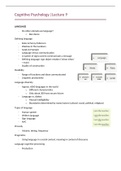Lecture notes
Violence against women
- Module
- Social Psychology
- Institution
- University Of Westminster (UOW)
This document cover the topic of Violence against women in current society. Covering female genital mutilation (types, prevalence, risks, tackling) and human/sex trafficking (prevalence, geography, focus, tackling)
[Show more]





